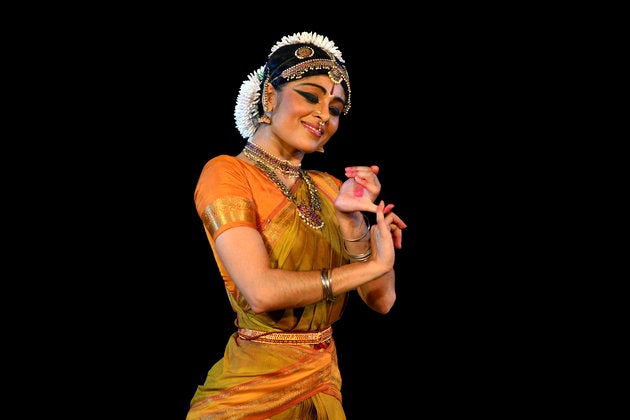
One of America’s most unusual dance dynasties reigns in Minneapolis: the trio of Ranee Ramaswamy, and her daughters Aparna and Ashwini.
In just over two decades, their company, Ragamala, has become the standard bearer of a singularly successful kind of hybridity, merging ancient traditions into high-end productions that major grant organizations find hard to resist. Their only other members are not of Indian origin. Together, the five dancers travel the world with first generation Indian-American women accompanists, bucking the classical hangup that true virtuosity is the domain of men.
Maybe it's the "Minnesota nice" effect, but the cutthroat vibe that usually attends Indian classical artistry isn't evident in the company's protocol either. Sweeping her arms upward at a rehearsal in Manhattan this past Sunday, in a move choreographed by her mother for the pièce de résistance of a bharatanatyam program -- the varnam -- Ashwini joked that the gesture reminded her of the Disney classic “Fantasia": “when Mickey calls up the waves.”
That sense of "mischief," to quote one reviewer, comes out in Ashwini's adami, the signature head movement usually associated with seduction. Offstage, the dissonance continues, with speech peppered in a cheery mix of pop culture references and the flat As of the midwest.
Ashwini was rehearsing for her solo Manhattan debut, made Tuesday night as part of the South Asian arts festival Drive East. In one wing of the studio sat Ranee, on nattuvangam -- brass cymbals used to keep time by the dancer's guru. Youthful at 63, she was the eldest there by a few generations. To her left sat vocalist Roopa Mahadevan, and flanking the two, sisters Anjna and Rajna Swaminathan on the violin and the mridangam respectively, the latter a barrel-shaped hand drum.
In her saffron half-sari set off by neon orange toenails, Ashwini looked up to the task of hooking modern viewers. Aparna sat directly in front of her so as to “nitpick” -- as she put it -- precisely. English, Tamil and Sanskrit flew. Everyone except Ranee occasionally dipped into Indian-isms for comic effect: “Why you do like that?” Aparna asked Mahadevan, when the singer mistakenly cut a jati off too quickly.
The women took pains to plot out the impact of fleeting moments, timing each step of Ashwini’s slower riffs, and building in space for Mahadevan to improvise with pleasure. “You should feel freedom,” Aparna told the singer gravely. Comic relief came during a recap of the varnam, in the form of a Tamil metaphor for lovers: a “creeper” vine and a tree. Ranee got an earful on the stalker vibes of a word the rest insisted only Indians use. “If I ever find a skinny man,” said Mahadevan, who with her curly hair and Venus shape, looks like a Renaissance painting, “I’m going to say, ‘You’re the creeper to my tree.’”
“I think we’ve got a good Hallmark card idea here,” Ashwini shot back.
The Ramaswamys function on an "adapt or die" mentality, but “fusion” is a bad word. They say they haven’t yet found a term dimensional enough to please them. “You wouldn’t believe how many people ask us if we’ve done something with flamenco,” Aparna says later, sitting at a café down the street from La MaMa, the experimental performance space where Drive East unfolds through mid-August.
The elder of the two, Aparna is ferocious where Ashwini is affable. She gets visibly charged when she explains why the company, which doubles as a small dance school, doesn’t "do arangetrams."
For Indian-Americans, the word itself conjures up an entire culture. Think wedding, quinceañera and bat mitzvah madness rolled together, only with the star of the show dancing for three hours with the help of live musicians flown in from India, and flower arrangements from Holland and Hawaii. Literally translated to “ascending the stage,” the arangetram is essentially a debut performance. What was once the purview only of dancers with intentions of going pro has become a standard rite of passage for Indian-American high schoolers set to switch their sights onto medicine or engineering come fall. Over the years, one-upmanship has scaled new heights, with some families booking the Lincoln Center or Carnegie Hall for their girl’s big day.
For non-Indians throughout the country, invited by colleagues or friends, these events can be a primary mode of dance education. This primacy troubles the Ramaswamys. “As a cultural representation, community productions are not always of the highest quality,” Aparna says carefully. “And it’s hard for audiences to tell the difference.”
In some respects, the apocryphally old dance form enchants easily. Bharatanatyam dancers dress in peacock-bright pleated costumes, sewn from saris. Good footwork is thrilling, and experts can seem to fly in the air when they get going. Then there are the stretches of abhinaya, or expression, which can feel like avant-garde theater. Scenes take shape with mudras -- hand gestures -- depicting every magical Indian icon, from the elephant to the peacock to the pantheon of Hindu gods.
The flashy exterior belies an intense interior experience for the dancer. Aparna equates dancing to engaging in “prayer.” The soulfulness of the form is why collaboration must be approached respectfully, she argues. Mindless flamenco infusions are out. “You have to be thoughtful. It's not just about, ‘Oh, they have rhythm, and we have rhythm!’” she says, her eyes widening. “That's too shallow.”
Given the obsession with classical culture in Indian-American communities nationwide, the dearth of homegrown professionalism is striking. Rajna Swaminathan says she is one of two Indian-American women who plays the mridangam full time in the country. Those who do take the leap typically do so with the support of parents unswayed by the security of a career in medicine. Often, they are musicians themselves. The Swaminathans’ father, for instance, a physicist based in Maryland, is also an accomplished mridangist who accompanies visiting performers.
In this underpopulated landscape, cross-disciplinary collaboration is key. On the docket for Ragamala is a project with Amir ElSaffar, a talented Iraqi trumpeter. Last year’s “Song Of The Jasmine” -- run at the Lincoln Center, which also co-commissioned the production -- featured the Indian-American jazz composer Rudresh Mahanthappa. In the lead-up, he decamped to Minneapolis to workshop with the Ramaswamys, a process that involved poring through love poetry by the eighth-century Tamil poetess Andal. The result was an original work heralded in The New York Times as “infectious.” “You don’t generally go to a performance of Bharatanatyam,” began the review, “expecting to want to get up and dance.”
The key in mixing forms is “finding a thematic bedrock,” Aparna says. Tapping into a shared idea -- the parallel between romantic and spiritual love, perhaps, or, as in the case of jazz and Carnatic traditions, a love of improvisation -- yields entry points. Engaging fully in the creative stages "allows wider audiences to understand the complexity and the richness of the individual forms," Aparna says.
The Ramaswamys' obsession with the idea of individual integrity comes from their teacher, Alarmel Valli. A legend in India, Valli is trained in a style known as pandanallur. A guiding metaphor is of a feather blown into a straight line. “That interplay of grace and strength,” Ashwini credits as the basis for the style's every movement.
A point of distinction for Valli is to access one's personhood on stage. The Ramaswamys are schooled to some extent in themselves. Where Aparna is fierce (in the family mythology, she knew she was going to be a dancer at the age of three), Ashwini is a wanderer. Both women are graduates of Carleton College, a liberal arts school not far from where they grew up. After graduation, Aparna worked on Ragamala with their mom while Ashwini headed to New York, spending a few years in the book publishing world before turning back to what they jokingly call “the family business.”
In childhood too, the girls diverged. “I was more of an American kid,” Ashwini says, rattling off her list of interests: writing, drawing, singing. “Most American kids try all the activities,” Ranee says pragmatically. “They don’t go deep, they go out.”
Aparna, she contrasts, “was ready to be molded” the moment she saw Valli perform, as a young girl. That first glimpse became the family’s origin story. Living in Minneapolis, they rarely saw the big visiting artists from India, who mostly toured the diasporic hotspots: New Jersey, Texas, California. When Valli came to town in 1982, “she changed the city,” Ranee says. Non-Indians and Indians alike turned out for what would become the first of many appearances in Minneapolis.
By then, Ranee had become the small community’s de facto performer. “Women my age were not usually trained at all,” she says. Her first marriage, to Ashwini’s and Aparna’s father, was arranged, into a family who “didn’t even like me to hum,” she says. “They thought it wasn’t proper for a Brahmin woman to perform,” and so she pursued her childhood passion tepidly, performing to taped music at community events that didn't require much soul-searching.
Her eventual divorce set the three women in motion toward the stage. They began to take annual pilgrimages to India to learn at the feet of Valli, who encouraged Aparna to access her fire, and Ashwini to let her playfulness shine through.
The counterintuitiveness of their lives (relatedly, all three women are now married to non-Indian men) seems to give them pleasure. "We're not one or the other culture, so why would our work be?" Aparna says.
Indeed, they seem to be performing even when they're not. At the end of rehearsal, Ashwini mugged one last time. “The best feeling is being done,” she said, panting a little after the final leg of her thillana -- all leaps and quicksilver footwork. Then, a smile, as if she didn't mean that at all.
